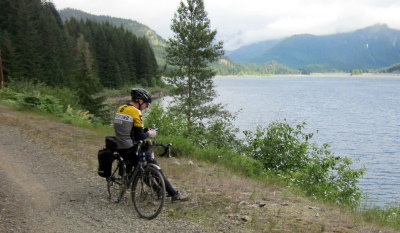 My annual goal is to ride my bicycle 4,000 miles. Last year I made it, partly because a bicycling buddy inspired me with this quest for 10,000 miles.
My annual goal is to ride my bicycle 4,000 miles. Last year I made it, partly because a bicycling buddy inspired me with this quest for 10,000 miles.
Russell Rogers, above at Lake Keechelus, had a full-time job, fixed up his house in Sequim for resale, and relocated to Pennsylvania last year. In spite of that, he still put 10,000 miles on his bikes in 2011.
How did he do it? He shared some tips in his blog, The Flying Abalone Bicycle Club, and in conversations with me.
Not difficult
“I think I can summarize it like this, physically speaking it isn't that hard. You only have to average 27.39 miles a day. Which is something almost any avid cyclist can handle. Even if you ride only 5 days a week, taking the weekend off, you only need to average 38.31 miles a day, which again, is not that difficult.”
As for Russell, who keeps copious records, he rode 252 days in 2011, with 113 days off. Two-thirds of his rides were between 30 to 50 miles.
He lit up his bikes so he could ride safely at night or inclement weather, usually on the Olympic Discovery Trail that rolls from Sequim to Port Angeles and beyond. He ran errands on his bike, often taking a long route to extend his miles. Also, he often commuted by bicycle. If he had a meeting to attend, he'd sometimes drive part of the way then complete the trip by bicycle.
Three obstacles
In the past, three obstacles to achieving high mileage were time, luck and motivation.
Being away from his wife and two sons, who moved to Pennsylvania ahead of him, from January through August helped give him time to achieve his miles, especially at night. Getting out regularly became more difficult when he rejoined his family.
Russell had good luck with his health last year, and avoided the broken forelimbs, allergies and leg infections that befell him in previous years. His bike stayed healthy too.
 Regarding motivation: “You would think that motivation to ride a bike would not be a problem. However, there were many days where I looked at the bike and thought 'if I have to get on that ***** bike one more ******* time…' You get the picture. There were many days where I had to force myself to get dressed and get going. In almost every instance where this happened, after a few minutes of riding I was glad that I did. Still, it is a long haul that can wear on you mentally.”
Regarding motivation: “You would think that motivation to ride a bike would not be a problem. However, there were many days where I looked at the bike and thought 'if I have to get on that ***** bike one more ******* time…' You get the picture. There were many days where I had to force myself to get dressed and get going. In almost every instance where this happened, after a few minutes of riding I was glad that I did. Still, it is a long haul that can wear on you mentally.”
Weather
The weather didn't play much of a factor. Most bicyclists get used to riding in inclement weather in the Pacific Northwest.
“If you wait around for only good days to ride, you won't ride much,” Russell says. “I also learned very early on that if you are not comfortable you won't ride much. I've invested more into cycling garments than I have into my bikes.”
He dresses in layers in cold weather and finds that windproof garments are more comfortable for him than waterproof, which hold in the sweat.
“There a few weather conditions where I just don't go out. I don't like to ride in thick fog or heavy rain because of motorist visibility. … I don't like riding in strong winds where controlling my bike becomes a safety issue. I don't like riding my bike when there is icy surfaces.”
Nutrition
Russell paid close attention to his “calories in and calories out” during the first 7 months of the year as he was trying to reach his goal of 160 pounds (down from 225 in 1995). He tried to keep his intake 1,000 calories less than his output. He stopped counting in July when he hit 158 pounds.
“I try to eat a sensible diet. I avoid most processed foods. I rarely eat fast foods. I love to cook, so eating fresh stuff was not an adjustment for me. I love meats, but I don't eat “American” sized portions. There is just no reason to have a 10-20 oz steak. French cuisine, as rich as it is, really has a good handle on portion size.”
Russell said a recent article in Bicycling magazine — “14 ways to eat like a cyclist at the Tour de France” — has guidelines for a sensible diet.
New goal
For me, the more I ride my bicycle, the easier it is to head out the door for another ride. As my condition improves, I think less about how many hills or miles are on my route and more about what there is to see or experience.
Russell's next goal is to improve his climbing. There's a hill outside of town that he must summit on just about every ride. At 1.5 miles long, it averages about 5% or 6%, with one steep at 15%. He's shooting to improve his time considerably; I'm sure he will.
Photos from our overnight bike tour up to the Snoqualmie Tunnel in July 2011.

Recent Comments